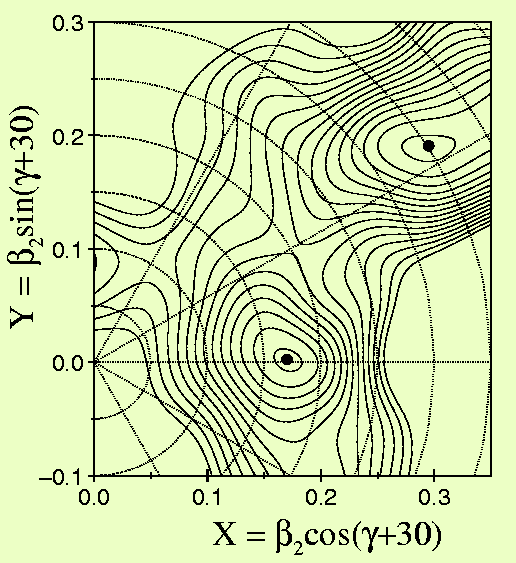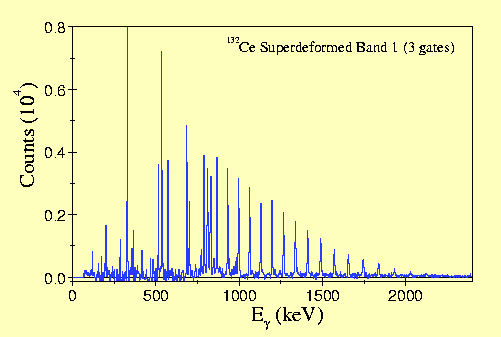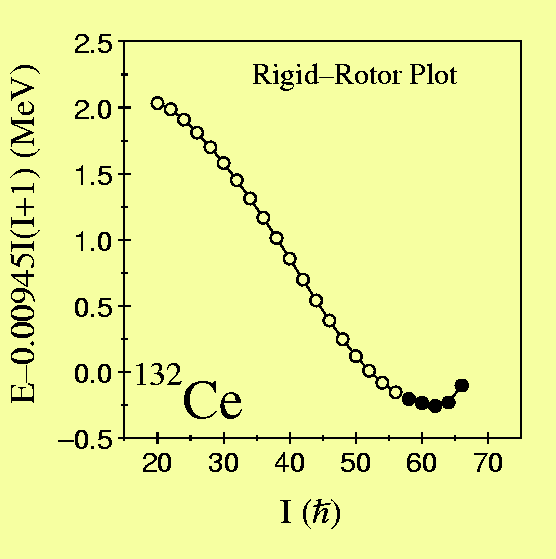


The observation of superdeformed (SD) structures, which are stabilised at high spin in nuclei, has been the source of much interest and investigation in recent years. These SD structures are based on a secondary energy minimum in the nuclear potential energy surface at much larger quadrupole deformation than the nuclear ground state, and have provided an ideal opportunity to investigate the combined effects of quantal shell structure and collective rotation. The initial discovery of superdeformation at high spin was found in the nucleus 132Ce of the light rare-earth region and manifested itself as a long regular series of gamma-ray transitions with an energy separation of approximately 70 keV. Superdeformation at high spin has subsequently been observed in other mass regions. More information can be found in the Table of Superdeformed Bands and Fission Isomers.

The initial discovery of superdeformation at high spin was found in
the nucleus 132Ce of the light rare-earth region and
manifested itself
as a long regular series of gamma-ray transitions with an energy
separation of approximately 70 keV, shown below.
In this mass region, the SD structures
roughly correspond to a prolate nuclear shape with a
major-to-minor axis ratio of 3:2.
With the advent of the new generation of highly efficient
gamma-ray spectrometers,
the number of observed SD structures has increased dramatically
allowing significant progress to be made in this mass region over the
last few years. This has included the observation of excited
superdeformed bands in
individual nuclei, the first unambiguous observation of identical bands in
neighbouring nuclei, evidence for
![]() I=2
energy staggering effects in Ce nuclei, and detailed quadrupole moment
(nuclear deformation) measurements.
I=2
energy staggering effects in Ce nuclei, and detailed quadrupole moment
(nuclear deformation) measurements.

The Liverpool group has concentrated on detailed spectroscopy of cerium isotopes (Z=58) around 132Ce. Experiments using the EUROGAM spectrometer have established excited SD bands in 131Ce [Ref] and 132Ce [Ref], the first nuclei to show multiple SD structures in this mass region. Experiments using GAMMASPHERE established further SD bands in 133Ce [Ref] and allowed precise relative deformation measurements of all the SD bands in 131,132Ce [Ref]. This has allowed the following question to be addressed: Are the SD shapes induced by single-particle shell gaps at high spin or by specific deformation-driving intruder orbitals? It has also been found that the bands in 131-133Ce follow "identical" band relationships [Ref], whereby gamma-ray transitions in one band or nucleus are at the halfway or quarterway points of transitions in another band. These relationships help in identifying the single-particle orbitals at the nuclear Fermi surface. Further identical band relationships were found in 133Pr (132Ce plus an extra proton) where four SD bands were found from EUROGAM data [Ref]. The properties of these latter bands suggest that the exact nuclear SD shape is regulated by the active valence orbitals at the Fermi surface.
A further, very interesting finding of the SD bands in 131-133Ce
is a ![]() I=2 energy
staggering of the gamma-ray transitions
[Ref].
This results in the rotational SD bands "splitting" into
two parts with states separated by
I=2 energy
staggering of the gamma-ray transitions
[Ref].
This results in the rotational SD bands "splitting" into
two parts with states separated by
![]() I=4
shifting up in energy and the intermediate states shifting down in
energy. The magnitude of the energy shift is typically only
50 eV compared to the gamma-ray transition energies of typically
1-2 MeV. It is only with the immense resolving power of the new
generation of gamma-ray spectrometers that such minute perturbations
can be measured! Although this effect has been observed in isolated
cases in other mass regions, it is only in this mass region that
the effect has been observed across a series of neighbouring isotopes.
This "bifurcation" effect represents a severe theoretical challenge
to current nuclear structure models and a conclusive interpretation
is still awaited. For instance, does it represent a new,
unexpected four-fold symmetry in the nuclear Hamiltonian?
I=4
shifting up in energy and the intermediate states shifting down in
energy. The magnitude of the energy shift is typically only
50 eV compared to the gamma-ray transition energies of typically
1-2 MeV. It is only with the immense resolving power of the new
generation of gamma-ray spectrometers that such minute perturbations
can be measured! Although this effect has been observed in isolated
cases in other mass regions, it is only in this mass region that
the effect has been observed across a series of neighbouring isotopes.
This "bifurcation" effect represents a severe theoretical challenge
to current nuclear structure models and a conclusive interpretation
is still awaited. For instance, does it represent a new,
unexpected four-fold symmetry in the nuclear Hamiltonian?
The latest work in this mass region has extended the SD systematics to lighter nuclei and has established weak (10-3-10-2 population intensity), multiple SD bands in the N=72 isotones 130Ce [Ref] and 132Nd [Ref], and in several odd-odd praseodymium (Z=59) [Ref] and promethium (Z=61) isotopes. Again the superlative resolving power of the new spectrometers has facilitated these discoveries! In addition, the large data sets from the new spectrometers allow a thorough spectroscopic analysis of the low-spin, normally deformed structures, including precise measurements of gamma-ray multipole mixing ratios and linear polarisations [Ref]. These studies are vital in establishing definite spin and parity assignments to the observed, normally deformed band structures. The measurements greatly help in inferring the spin and parity of the high-spin SD structures by observing where they feed into the low-spin structures. In nearly all cases of superdeformation, no discrete gamma-rays have been observed linking the SD bands into the low-spin structures. This problem of linking transitions between superdeformed and normally deformed structures is currently a very active topic of nuclear structure research.
It is important to extract deformations of superdeformed bands and
this can be done by measuring the lifetimes of states within the
bands. This may be achieved using the Doppler Shift Attenuation
Method (DSAM) whereby Doppler shifts of the
![]() -rays, recorded
at specific detector angles, are measured, when emitted from a
moving source that is slowing down in a metal foil. An example
is shown below for the superdeformed band in 133Nd.
-rays, recorded
at specific detector angles, are measured, when emitted from a
moving source that is slowing down in a metal foil. An example
is shown below for the superdeformed band in 133Nd.

Comparison with nuclear stopping theories allows nuclear lifetimes, quadrupole moments, and hence deformation, to be extracted. Examples of transition quadrupole moment measurements are shown below for superdeformed bands in 131,132Ce. In this mass region, the results are consistent with deformed shapes with a 3:2 axis ratio [Ref]. It can be seen below that SD band 2 in 131Ce has a larger quadrupole moment, and hence deformation, than the other SD bands shown.

Superdeformed bands are based on shape-driving intruder orbitals, such as i13/2 neutrons. However, other orbitals can also polarise the nuclear core and enhance the quadrupole deformation. In 133Pr [Ref], there is evidence for a shape change at high spin induced by h9/2 neutrons. The results, obtained with the EUROGAM spectrometer, are shown below.

Results for 132Ce, obtained with the EUROBALL IV spectrometer with the INNER BALL, suggest that the yrast SD band is approaching termination at the highest spins. This can be seen in the rigid-rotor plot below which is similar to those of the terminating bands of mass 110 nuclei (Click here to see slides from the EUROBALL Workshop, March 2002).

The latest results from a high-spin, high-statistics experiment with GAMMASPHERE, performed at the Argonne National Laboratory, USA, have yielded many new superdeformed bands in 132Ce and its neighbouring nuclides.
In order to populate the very lightest, most neutron-deficient
isotopes, radioactive ion beams will have to be used instead of
stable beams in heavy-ion fusion-evaporation reactions. A
collaboration has recently been initiated at the
Holifield
Radioactive Ion Beam Facility, Tennessee. A preliminary
study using a stable 70Ge beam to bombard a
58Ni target has been performed, while a
complementary study using a 69As or 56Ni
radioactive beam is envisioned in the near future.
In this study,
six four-element clover and four single-crystal HPGe
detectors were placed around the target position.
Recoiling evaporation residues leaving
the target foils were focused through the Recoil Mass
Spectrometer (RMS). A Position Sensitive
Avalanche Counter (PSAC) was mounted at the RMS
focal plane to provide mass identification, via the mass-to-charge
ratio (A/Q), of spatially
separated (horizontally) recoil products. The PSAC consisted of
two electrically separated halves, wide enough to span two charge
states of the recoils arriving at the focal plane.
An Ionization Chamber (IC), similarly consisting of two halves,
was mounted behind the PSAC providing
total-energy (E) and energy-loss ( E)
signals for Z discrimination. Using this equipment,
it has been possible to identify
excited states in 125Ce
[Ref].
By using the radioactive beam, it is hoped to study the lighter
122,123Ce isotopes in the near future.
E)
signals for Z discrimination. Using this equipment,
it has been possible to identify
excited states in 125Ce
[Ref].
By using the radioactive beam, it is hoped to study the lighter
122,123Ce isotopes in the near future.
This work has been carried out in collaboration with groups from York University (UK), Grenoble (France), Debrecen (Hungary), Lawrence Berkeley National Laboratory (USA), Florida State University (USA), and HRIBF (USA).
Document Last Modified
Maintained by Eddie Paul <esp@ns.ph.liv.ac.uk>